Why are there TWO Witnesses in Revelation?
One Witness is Fairly Easy to Identify, but Who is the Other?
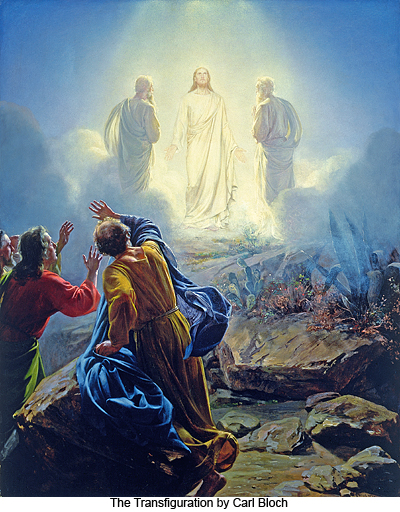 T
T
his little study will answer many questions, the first one being: why are TWO Witnesses referred to in Revelation Chapter 11? Perhaps it's never crossed your mind to ask. Perhaps it seems unimportant, or even irrelevant, but nothing is irrelevant in prophetic scripture.
We have heard much of Elijah being one of the two witnesses, and this is probably because of the mention he gets in other parts of scripture, such as the one in Malachi 4:5 telling Israel to watch for the reappearance of Elijah in the latter day.
Jesus, as we know, was asked if HE (Jesus) were Elijah, to which he replied NO, but he pointed to John The Baptiser as being the Elijah of His day.
Thus we have assurance from the Lord himself that Elijah will indeed reappear, but we do not yet know if that will be a symbolic or a real-life appearance.
The identity of the other Witness has been disputed. Suggestions have been Enoch, John, a Gentile type of Elijah, Moses, the Church, or just a symbolic reference. Some early writers, such as Tertullian, Irenaeus, and Hippolytus of Rome, identified the two witnesses as Enoch and Elijah, prophets who did not die because God "took" them.
But others have proposed Moses as one of the witnesses, for his ability to turn water into blood and the power to plague the earth. That has become my conviction too, for reasons I will demonstrate throughout this article.
The Transfiguration
There is a less obvious mention of the Two Witnesses in the gospels, and that is during the Transfiguration. (Matthew 17:1–9, Mark 9:2-8, Luke 9:28–36)
Both Elijah and Moses appeared alongside Jesus, in shining garments, on that Mount. Here we surely have the two endtimes witnesses, who perhaps had come anticipating their reappearance in the latter day, only to find that they had to wait another two thousand years before the task was done.
The Vision of Zechariah
The identity, ministry and particulars of the Two Witnesses becomes even more clear when we look at them in other prophecies. The principle text is found in the book of 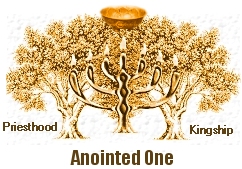 Zechariah, because John of Revelation does identify these two men as the two olive trees (the two anointed ones) that stand alongside the Menorah lamp in Heaven, seen in Zechariah's vision.
Zechariah, because John of Revelation does identify these two men as the two olive trees (the two anointed ones) that stand alongside the Menorah lamp in Heaven, seen in Zechariah's vision.
Right away, we can see the similarity between Zechariah's prophecy and the Transfiguration.
We see the central seven-branched lamp and the two anointed ones as olives to right and left. This is so similar to Moses and Elijah on either side of Jesus the Light of the World in the glory of their transfiguration that it can hardly be a coincidence.
Indeed, we see a TRIO in both instances. Jesus, depicted by the seven-branched lamp, is the anointed Prophet, Priest and King. He unites within himself all three aspects, but in this particular heavenly vision we see those aspects separately as the lamp, and the two olive trees. Thus the olive trees denote PRIESTHOOD and RULERSHIP.
In the day of Zechariah, the two central personalities of his prophecy were also a RULER and a PRIEST. The Governor of Judah, Zerubbabel, and the High Priest Joshua were given the task of completing the Temple in Jerusalem, and restoring the city, land and people under God. And so it is in Revelation - but I'm running ahead of myself, because this also demonstrates another astounding fact, one that provides the identity and titles of two other endtimes characters, the Beast and the False Prophet.
Forerunners of the Two Witnesses
There have been several 'types' or forerunners depicting the activities and even the names of the Two Witnesses in Revelation. I will briefly discuss the leading candidates.
Moses and Aaron
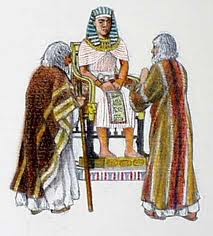 The first two people we examine as being types of the Two Witnesses of Revelation are Moses and his brother Aaron.
The first two people we examine as being types of the Two Witnesses of Revelation are Moses and his brother Aaron.
Moses was briefly abandoned by his Jewish mother to hide him from the Egyptians, but was drawn out of the river by a royal princess, who adopted him. Thereafter he was raised in the Egyptian court.
After fleeing Egypt and subsisting as a herdsman in the land of Midian for 40 years, Moses was confronted by God who appeared to him in glory, resembling a burning flame in a bush. God asked Moses to return to Egypt, and there command the Pharaoh to let God's people go. Shy and awkward, Moses backed off the task and God therefore appointed his elder brother Aaron to be a spokesman.
Following the pattern we see throughout this article, Moses was the Leader, and Aaron was appointed as the spokesman and miracle-working prophet side of this twosome. Because Moses complained that he could not speak well, God appointed Aaron as Moses' "prophet" (Exodus 4:10-17; 7:1). At the command of Moses, he let his rod turn into a snake (Exodus 7:9-12). Then he stretched out his rod in order to bring on the first three plagues (Exodus 7:19, 8:1,12).
The two men together confronted Pharaoh and eventually led the people out into the wilderness to travel towards the land God had promised them. Aaron accompanied Moses part way up Mount Sinai to meet with God, (Exod 19:24) in a similar way to Joshua, and thus reproduces the Transfiguration, as described below.
On Mount Sinai, Moses received directions about the appointment of Aaron and his four sons to the Aaronic Priesthood. Aaron therefore (like most of the men in these shadows or types of the Two Witnesses), represents the Priestly whereas Moses represents Rulership.
Moses and Joshua.
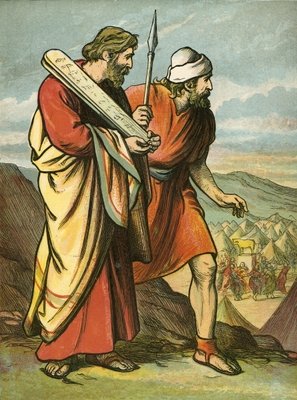 When Moses led the Israelites out of captivity in Egypt and across the wilderness towards the Promised Land of Canaan, which we now know as the land called Israel, his young servant and assistant was Joshua the son of Nun. Joshua also accompanied Moses when he ascended Mount Sinai to commune with God. (Exodus 24:13,14)
When Moses led the Israelites out of captivity in Egypt and across the wilderness towards the Promised Land of Canaan, which we now know as the land called Israel, his young servant and assistant was Joshua the son of Nun. Joshua also accompanied Moses when he ascended Mount Sinai to commune with God. (Exodus 24:13,14)
Moses and Joshua, alone with God on Mount Sinai, reproduce in an almost perfect way the picture we see of Jesus in his own day transfigured on the Mount giving instruction to Moses and Elijah. In both stories God appeared in glory and spoke from the cloud, and in both accounts the Glory of God "settled" on the mountain (Exodus 24:16 and Mark 9:7)
The Hebrew word for settle is "shakan" (Strong's 7931) and means, "to settle temporarily or to tent, or abide in a temporary dwelling" and from it we get the word Shekinah, the presence of God. In the account of the Transfiguration, Peter uses the same word to suggest they build something temporary, as if to duplicate the Sinai experience. Also, Luke 9:31 says, "They spoke of his departure" and the Greek word for departure is "Exodos" (Strong's 1841).
Zerubbabel and Joshua
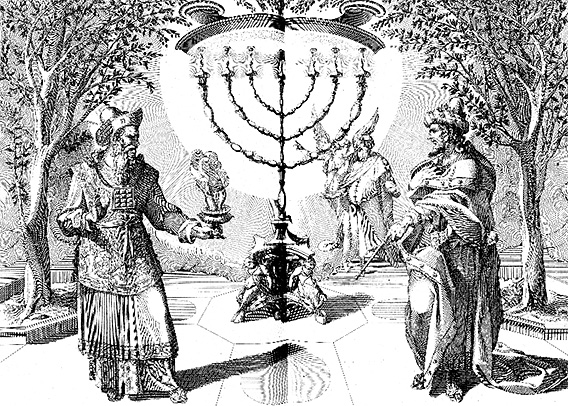
High Priest Joshua and Governor Zerubbabel as seen in the Zechariah Vision
Another deliverance from captivity is needed, this time from Babylon. Two of the leading characters in this story are the Governor of Judah, Zerubbabel, and the High Priest Joshua. Just as before, the political leader brings the people OUT of Babylon, and Joshua the Priest is appointed to restore the people's allegiance to God and his Law. In other words, to take them back IN to God's kingdom rule.
In 538 BC the Persian King Cyrus issued the decree allowing for a large number of the Jewish exiles to leave Babylon and return to Israel to rebuild the Temple in Jerusalem. Two years later, in 536 BC, the Jews succeeded in setting the foundation of the Temple and then they began to build the Temple itself. As the work began many 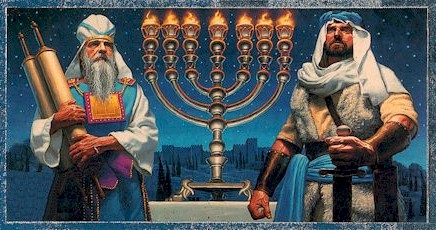 of Israel's enemies became worried and tried to discourage the builders. Eventually their harassment succeeded, and the work on the Temple stopped for more than a decade until the second year of King Darius of Persia.
of Israel's enemies became worried and tried to discourage the builders. Eventually their harassment succeeded, and the work on the Temple stopped for more than a decade until the second year of King Darius of Persia.
This was when the prophet Haggai stepped up to encourage the Jews who were living in Jerusalem to turn back to their task of rebuilding the Temple.
Haggai first scolds the Jews for building comfortable homes for themselves, while God's house remained unfinished.
Then he focused his attention on Zerubbabel, who was the political leader and governor of Judah, and on Joshua, who was the religious leader and high priest. These two men listened to Haggai, and encouraged the Jews to finish their job of rebuilding the Temple in the sixth year of Darius.
Zerubbabel and Joshua were two human beings and not literally - in the day of Zechariah's vision - the "two anointed ones" or olive trees standing by God in Heaven. Nevertheless, they represented them. They took on the character and task of those Anointed Ones that are to come, and show us a prophetic shadow of events that will soon take place in reality.
As before, Zerubbabel represented the Rulership side and Joshua the Prophetic/Priestly side.
Moses and Elijah
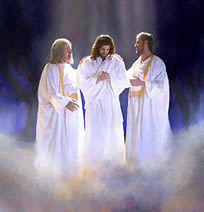 As mentioned above, these two men met with the glorified Jesus, once again on a mountain top. The situation is very similar to that of Moses and Joshua on Mount Sinai. As Moses was instructed to take Aaron, Nadab and Abihu up the mountain (Exod 24:1), so Jesus took Peter, James and John.
As mentioned above, these two men met with the glorified Jesus, once again on a mountain top. The situation is very similar to that of Moses and Joshua on Mount Sinai. As Moses was instructed to take Aaron, Nadab and Abihu up the mountain (Exod 24:1), so Jesus took Peter, James and John.
The timing of this event is significant, and has a bearing on the setting in the book of Revelation. It happened just after Jesus told His disciples that He would suffer, be killed, and be raised to life (Luke 9:22). Moses and Elijah appeared and talked with Jesus about His death that would soon take place.
The Two Witnesses are called to prophesy at a time of great persecution in Israel. In their own deaths they reproduce the death of their Lord Jesus - they are killed by the antichrist oppressor, lie dead for three and a half days and are then raised to Heaven. (Revelation 11)
Symbolically, the appearance of Moses and Elijah represented the Law and the Prophets. In each prefiguring of the Two Witnesses, we see a political side and a religious side, both united in a spiritual reality. The pattern can easily be seen in the chart below:
The Similarities
| POLITICAL REALM: Prince, Ruler, Leader, President |
HEAVENLY REALM: Messiah - Prophet, Priest and King |
RELIGIOUS REALM: Priest, Prophet, Healer, Miracle-Worker |
MOSES |
The EXODUSThe Burning Bush & |
AARON & JOSHUA |
Zerubbabel, King |
ZECHARIAH's VISIONMenorah 7-branched lamp |
Joshua, Priest (Yeshua) Name = God Saves |
| The LAW Moses: Leader, Ruler Name = Drawn out of the waters, also "Drawing Out" |
TRANSFIGURATIONJesus, The Branch |
THE PROPHETS Elijah the Prophet Name = Glorious Lord/God |
| MOSES He draws OUT of false kingdom |
THE TWO WITNESSES |
ELIJAH He draws IN to true kingdom |
"Come out of her my people" 1. Warns of false king |
"I am coming quickly and my reward is with me" 1. Prophesies of the coming King |
|
| BEAST-KING False Leader Will his name contain "drawing together"? |
DRAGON SPIRIT |
FALSE PROPHET False Priest/Prophet Will his name denote a false god or the devil? |
The Significant Names
It is a fact that we can see the nature of all these biblical characters by their names. In the Hebrew culture and religion, names are very meaningful. They denote the birth, character and sometimes the destiny of those named. We therefore cannot overlook the names of each of these forerunners of the witnesses. Knowing these names, we can see suggestions - as we go forward in time - of the titles, tasks and perhaps even the names of the biblical characters to come.
One: The Priestly-Prophetic Witness
Aaron
Although Aaron seems to be a type of the Witnesses jointly with Joshua, he does play a part, as the helper and companion of Moses and the first High Priest.
His name is not easy to fathom, being probably Egyptian in origin. But in the bible, foreign names often were transliterated into Hebrew in such a way that they began to mean something in Hebrew. Jones' Dictionary of Old Testament Proper Names derives Aaron from the Hebrew word הר (har) meaning mountain, thus the name Aaron is related to the Hebrew names Ararat and Haran.
Another way of looking at the name Aaron (as does NOBSE Study Bible Name List) is to follow the Hebrew root אור ('or) meaning to be or become light. There may even be relations between the name Aaron and the word ארון ('aron), meaning chest or Ark (see the name Aran). This word is used for an offer chest (2 Kings 12:10), a sarcophagus (Genesis 50:26) but mostly to indicate the Ark of the Covenant (Exodus 25:10).
We can see in the name of Aaron hints of what is to come - the glory and fire of God on the Mount, and the Ark of the Covenant that contained Aaron's "rod that budded" denoting his priesthood. Jones' Dictionary of Old Testament Proper Names reads "Very High" [Source]
Joshua
Both the Exodus story and the Zechariah vision have the name Joshua as one of the two participants. It's not surprising to discover that the name is the same as Jesus, or in hebrew Yeshua. Yeshua is the short form of the name Yehoshua, or Joshua. (See for example here). The prefix "Yeho" is an abbreviation of the Tetragrammaton, God's Four-Letter Name: Yod-He-Vav-He or YHVH. So Jesus and Joshua carry the name of God. And the second part of his name is from the Hebrew verb yasha which means to deliver, save, or rescue.
Thus, linguistically, the name Yehoshua/Yeshua/Jesus conveys the idea that God (YHVH) delivers (his people). It means YAH SAVES! The particular kind of rescue or saving that this word conveys is of a drawing out, or rescue, from a narrow confined place into a broad place of safety.
Joshua in the book of Zechariah is a High Priest, but did the servant of Moses also fulfill that task? Joshua certainly was present on the Mount when Moses went up to meet with God, for he pointed out to Moses the idolatry of the people on their descent. (Exod 24:13/ 32:17) The quote below suggests that Joshua had duties within the "Tent of Meeting" even before there was a role of Priesthood, and thus represents the priestly side of the Two Witnesses, just as did Joshua the High Priest in Zechariah.
Ex 33:7-11 And Moses took the tabernacle, and pitched it without the camp, afar off from the camp, and called it the Tabernacle of the congregation. And it came to pass, that every one which sought the Lord went out unto the tabernacle of the congregation, which was without the camp. And it came to pass, when Moses went out unto the tabernacle, that all the people rose up, and stood every man at his tent door, and looked after Moses, until he was gone into the tabernacle.... And the Lord spake unto Moses face to face, as a man speaketh unto his friend. And he turned again into the camp: but his servant Joshua, the son of Nun, a young man, departed not out of the tabernacle.
From what is written about Joshua we can see that he was AS Moses to the people, not just an assistant. (Josh 3:7) Moses and Joshua do fit the pattern of the Two Witnesses.
Joshua was commissioned by God to lead his people, (Num 27:15-23) he was said to have the Spirit of God (Num 27:18), and wisdom (Deut 34:9), he was specifically chosen to enter into the Promised Land (Deut 1:37-38) and the word of the Lord to Joshua could equally have been spoken to the Witnesses of Revelation in the last day, as seen below:
Deut 3:28 But charge Joshua, and encourage him, and strengthen him: for he shall go over before this people, and he shall cause them to inherit the land which thou shalt see. Deut 31:7-8 And Moses called unto Joshua, and said unto him in the sight of all Israel, Be strong and of a good courage: for thou must go with this people unto the land which the Lord hath sworn unto their fathers to give them; and thou shalt cause them to inherit it. And the Lord, he it is that doth go before thee; he will be with thee, he will not fail thee, neither forsake thee: fear not, neither be dismayed.
Elijah
Elijah's name is from the Hebrew Eliyyahu meaning "my God is YAHWEH".
The name Elijah combines two of the most common titles of God in the Bible: The word אל (El), the common abbreviation of Elohim (Elohim), meaning God (or gods), but most fundamentally possibly meaning power or strength. And YAH יה (Yah) = יהו (Yahu) = יו (Yu), which in turn is an abbreviated form of the Tetragrammaton; the name of the Lord: YHWH.
But there is more - a hidden meaning! In both Zechariah and Revelation 11, the two witnesses are likened to OLIVES. Here is another mystery that can be uncovered easily when we look at the text. The Greek word used for olive [tree] is pronounced ELIJAH! Strong's number G1636, elaia (el-ah-yah), olive, or berry. Compare Romans 11:17. The writer of Revelation chose to use the word elaia when he spoke of the two witnesses. Isn't that amazing?
Two: The Kingly-Rulership Political Witness
Moses
We have accounted for the Prophet-Priest Witness. But what of the Kingly-Ruler Witness? In two instances shown above, he was personified as MOSES, the divinely-appointed leader of Israel. What does the name Moses say, and is it linked to the Two Witnesses?
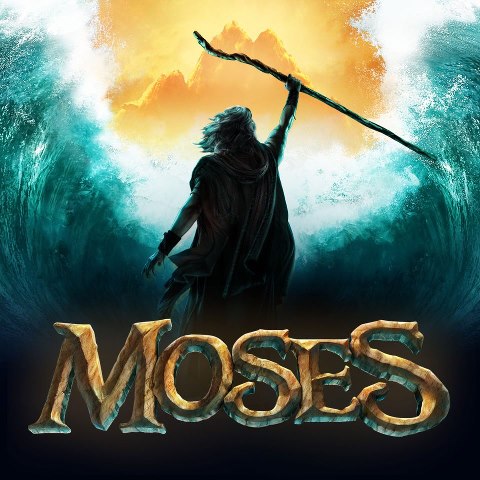 The etymology and original meaning of the name Moses have been long disputed. Jones' Dictionary of Old Testament Proper Names derives it from the Egyptian word for water, MO, and the verb to save out of water, 'USES'. BDB Theological Dictionary relates it to the Egyptian word MES/MESU, meaning child, son. Then there is the Hebrew verb משה (masha), which is near identical to the name. (See full explanation here).
The etymology and original meaning of the name Moses have been long disputed. Jones' Dictionary of Old Testament Proper Names derives it from the Egyptian word for water, MO, and the verb to save out of water, 'USES'. BDB Theological Dictionary relates it to the Egyptian word MES/MESU, meaning child, son. Then there is the Hebrew verb משה (masha), which is near identical to the name. (See full explanation here).
From the lengthy discussion on the source page we can glean that the name Moses has to do with rising up and removing, to lift up and carry away. The bible tells us that the name of Moses had to do with being "drawn out" of the water: Ex 2:10 ...she brought him to Pharaoh's daughter, and he became her son. So she called his name Moses , saying, "Because I drew him out of the water."
But the word in Hebrew denotes at the same time purity, because clean white clothes are drawn out of the water after being washed. However, the verb משה (masha) means to draw, and in the bible, both instances of the word revolve about someone being drawn out of water. In the first instance, baby Moses is drawn out of the Nile, 'and in the other instance king David expresses his gratitude to the Lord, who has saved him by drawing him out of many waters (2 Samuel 22:17 = Psalm 18:16).
We can't stop there, because Moses was the father of two sons (1 Chron 23:25 "The sons of Moses were Gershom and Eliezer".) They also display the prophetic meaning in their names:
- Gershom = "a stranger there" (Ex 2:21-22) Zipporah... bore him a son. He called his name Gershom , for he said, "I have been a stranger in a foreign land." But a verb that may have been on Moses' mind is גרש (garash), meaning to drive or cast out, as he himself had been driven out of Egypt. The root-verb גרש (garash) expresses a strong force predominantly aimed at expulsion of some sort. It's mostly used to describe people being driven away from a place (Genesis 3:24) other people (Exodus 10:11, 1 Samuel 26:19), or the Lord (Genesis 4:14).
- Eliezer = "the God who helps", particularly in battle or in distress. This is near identical in meaning to Yesh-shua, God delivers.
So once again, there are two men, one named "driving OUT" and the other "God helps".
Now we can understand more of the ministry of the Two Witnesses. One draws OUT of bondage and danger, often by an appeal to military and political intervention. The other draws IN to the Kingdom of God, by prophecy and an appeal to the Law of God.
Zerubbabel
As seen in the accompanying chart, the two personalities called to minister in Zechariah's day were called Zerubbabel and Joshua.
Zerubbabel was a governor of the Persian Province of Judah (Haggai 1:1 ) and the grandson of Jehoiachin, penultimate king of Judah. Zerubbabel led the first group of Jews, numbering 42,360, who returned from the Babylonian Captivity in the first year of Cyrus, King of Persia (Ezra). The date is generally thought to have been between 538 and 520 BC. Zerubbabel also laid the foundation of the Second Temple in Jerusalem soon after.
In all of the accounts in the Hebrew Bible that mention Zerubbabel, he is always associated with the high priest who returned with him, Joshua (Jeshua) son of Jozadak (Jehozadak). Together, these two men led the first wave of Jewish returnees from exile and began to rebuild the Temple (Source).
If the name Zerubbabel is Hebrew, it may be a contraction of Zerua Bavel, meaning "the one sown of Babylon", and referring to a child conceived and born in Babylon; or perhaps even, Zeruy Bavel, meaning, "the winnowed of Babylon", in the sense of being exiled in Babylon. Just as the name Moses can be translated 'son' (therefore the seed of a man) so Zerubbabel can be translated as seed or one sown in Babylon.
Did God allude to this when he instructed Joshua in Zech 6:12 to "Behold, the man whose name is the BRANCH" . But clearly God was looking far beyond Zerubbabel and pointing to Jesus who would complete the task of returning Israel to her inheritance. (Is 11:1)
Coming OUT
The name Zerubbabel consists of two parts. The second part of this name is obviously the same as the Hebrew word for Babel / Babylon. The first part may be taken from the Hebrew verb זרע (zara'), meaning to scatter seed or sow, or its derived noun זרע (zera'), meaning seed or offspring. If the name of Zerubbabel is Assyrian-Babylonian, it may mean the "Seed of Babylon", the one conceived in Babylon. Zerubbabel may have had a Babylonian style name because of his interaction with the Babylonian court.
Tradition dictates the meaning of the name Zerubbabel to be Seed Of Babel, or something to that extent, but seeing that in the story Zerubbabel applied enough pressure on the governing body of Babylon/Persia to be allowed to lead the people back to their Promised Land, the literary character of Zerubbabel is strongly reminiscent of that of Moses. The name Moses probably originated as an Egyptian name, but written in Hebrew it obviously means Drawn/Drew Out [Of Egypt]. Hence, to a Hebrew audience, the name Zerubbabel must have looked like "Pressed Out Of Babel". [Source]
To his countrymen who were Hebrews, the name of Zerubbabel signified the withdrawing or coming out of Babylon, because not only did his name suggest a winnowing of the grain and chaff, a separation of the seed, but they experienced first-hand and literally his returning the exiles to Jerusalem.
And it is also true that his name can be translated as "pressed out" of Babylon. The root-verb זור (ZUR) means to press down and out. It's used only four times: In Judges 6:38, Gideon presses his fleece to drain the water out. in Job 39:15 the Lord speaks of an ostrich who forgets that a stumping foot may crunch and drain her egg. The prophet Isaiah uses this verb in a medical sense when he speaks of pressing out a wound (Isaiah 1:6), and uses it to describe how a crushed snake's egg brings forth a snake (Isaiah 59:5). [Source]
Now we see that Moses could be translated as both SEED/son or DRAWN OUT, and likewise Zerubbabel can mean SEED/son or PRESSED OUT.
From captivity in Egypt, two men - Moses and Joshua - led the people out; from captivity in Babylon two men - Zerubbabel and Joshua - led the people out and established them in the land. How can we avoid the conclusion that once again Israel will be led out of her present-day captivity by two men anointed for that task, the two witnesses Moses and Elijah?
The Counterparts of the Two Witnesses
Let's take this one step further. We've seen that two prominent men are used by God to deliver Israel from captivity, to identify both the false and the true King, and to call Israel back to God. But we also see two prominent men in Revelation who are the anti-type and antithesis of the Two Witnesses. They are the Beast-Ruler and the False Prophet.
Just as Moses is a Leader of his people and Elijah is a Prophet, so their counterparts are a Ruler and a Prophet. (Revelation 13) We can learn more about them by comparing and contrasting them with the Two Witnesses. In particular, we have perhaps a hint of their names!
- The political side of the Anointed Ones (two witnesses) has a name suggesting a SON or a SEED, also by extension, a BRANCH and at the same time the meaning DRIVES OUT, expels, exiles, winnows out the chaff.
- The priestly/prophetic side has the name of GOD, and Jesus! He speaks of God by name (The Tetragrammaton) and testifies to God's power and ability to deliver.
As seen in the chart above, the Two Witnesses have matching but differing tasks. The Priestly-Prophetic side has the task of witnessing to the coming King Jesus and calling the people to enter IN to His Kingdom through repentance and re-dedication to God, just as did John The Baptiser in the day of Jesus. The Rulership side, exemplified as Moses, has the task of calling the people OUT of Babylon. Revelation 18:4 .'And I heard another voice from heaven saying, come out of her My people, that ye be not partakers of her sins and that ye receive not of her plagues.'
MOSES Witness WILL:
- Confront the false king, the Beast, and disrupt and oppose his rule, earning absolute hatred in return
- Urge the people of Israel, despite their fear and reluctance, to escape the oppression of a tyrannical government.
- Identify, using many God-given signs, the deceptions and identity of the Beast
- Call down and bring about many severe judgements and plagues as a result of the Beast's reign
ELIJAH Witness WILL:
- Prophesy against idolatry and point to the coming Rule of God
- Use genuine signs and wonders to demonstrate the power of God
- Urge Israel to repent, prepare, and seek to enter the Kingdom of God
- Identify and point to Yeshua as the true King
Same Role, Opposite Meaning
Just as Moses and Elijah have a genuine mission, authority and power from God, so the FALSE Ruler and FALSE Prophet to come will mimic these names and attributes. They may be the exact opposite. For instance the Ruler will perhaps have a human name suggesting drawing together, unity, or gathering together, instead of drawing OUT like Moses. The Prophet will perhaps have a name of a false God, or even a corruption of the Tetragrammaton which would be the ultimate blasphemy.
Revelation 13:4-7 "and they worshiped the beast, saying,'Who is like the beast? Who is able to make war with him?' And he was given a mouth speaking great things and blasphemies, and he was given authority to continue for forty-two months. Then he opened his mouth in blasphemy against God, to blaspheme His name, His tabernacle, and those who dwell in heaven". And also Rev 17:3 "a scarlet beast which was full of names of blasphemy".
There are so many possibilities (just as with working out the name that adds up to 666) we really cannot know in advance what these two names will be. However, having a clue about them is helpful, all the same.
Activities Compared
The known activities of the Beast and False Prophet are also counterparts of the Two Witnesses, confirming the identity of both. That is, what we know of Moses and Elijah both in the future and in the past are mirrored in the actions of the Beast and False-Prophet twosome. For instance:
- MOSES: rises from the river
- BEAST: rises from the sea
- MOSES: accompanied by Aaron who performed miraculous signs to validate Moses' mission
- BEAST: accompanied by False Prophet who authenticates him by performing lyings signs and wonders
- MOSES: causes great plagues in the land including turning sea to blood and profound darkness
- BEAST: causes great judgement from God including sea to blood and great darkness
- MOSES: establishes Law and Feasts of God
- BEAST: changes laws and seasons
- MOSES: created Council of Seventy to share rule
- BEAST: creates ten kings who rule with him
- MOSES: meets with God in the Tabernacle
- BEAST: sits as god in the Temple
There may be many other similarities but this is enough to establish the principle. And what happens when we compare Elijah to the False Prophet? The same thing occurs, we see many similarities:
- ELIJAH: has ministry of three and a half years
- FALSE PROPHET: is given authority for three and a half years
- ELIJAH: opposes Ahab and Jezebel
- FALSE PROPHET: affirms Beast-Ruler and Harlot
- ELIJAH: calls down fire from heaven to show God's power
- FALSE PROPHET: calls down fire from heaven to deceive mankind
- ELIJAH: urges Israel to worship God
- FALSE PROPHET: causes mankind to worship the Beast
Once again, you may be able to point out many other similarities, but this is enough to establish that the False Prophet is actually a mimic and anti-type of Elijah, and one of the Witnesses in the endtimes.
In Conclusion
A study on the Two Witnesses may feel self-indulgent at this end of history, and some may find it boring. But knowing their mission, character and names helps us see God's provision for Israel, and also avoids wrongly identifying these two, as some have already done.
I hope that I have answered the question with which I began: why are there TWO witnesses, not just one. God has ordained both political and spiritual action to combat the forces of Antichrist. As well as that, it reinforces my previous opinion that the False Prophet has the character and activity of an "anti-christ" (being the false type of Elijah) doing lying signs and wonders, whereas the Beast is a political ruler who mimics the authority of a Moses in leading Israel.
And like the Two Witnesses now and throughout the bible, they represent two halves of a whole: one is a godly deliverance and the other is a satanic bondage.
© 2015 Tricia Tillin. All rights reserved. Birthpangs Website: http://www.birthpangs.org/ This document is the property of its author and is not to be displayed on other websites, redistributed, sold, reprinted, or reproduced in printed in any other format without permission. Websites may link to this article, if they provide proper title and author information. One copy may be downloaded, stored and/or printed for personal research. All spelling and phraseology is UK English.
